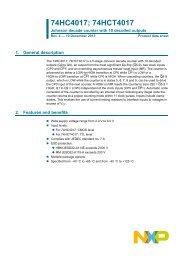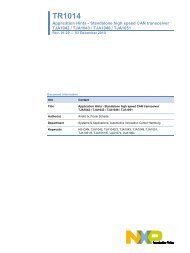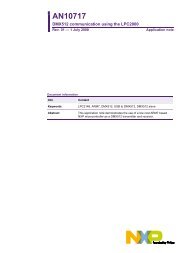AN108711 - NXP Semiconductors
AN108711 - NXP Semiconductors
AN108711 - NXP Semiconductors
Create successful ePaper yourself
Turn your PDF publications into a flip-book with our unique Google optimized e-Paper software.
Philips <strong>Semiconductors</strong><br />
Figure 2 Reaching the NFC Protocol<br />
Application Note<br />
Tips and Tricks for PN51x Integration<br />
Figure 2 shows that the Active Mode is the most straightforward (and fastest) way to<br />
reach the NFC protocol. The protocol flow is described in a more detailed way in the next<br />
chapter.<br />
1.4.1 Passive Communication mode<br />
In passive mode the Initiator first has to check if there is already an existing RF field. If<br />
yes, it is not allowed to act as Initiator. If no RF field is detected, the Initiator starts the<br />
communication by generating the RF field and sending the data according to the<br />
appropriate bit representation at the selected bit rate. The target then answers to an<br />
initiator command in a load modulation scheme, where the type of modulation also<br />
depends on the bit rate. The Initiator always generates the RF field for the target. As long<br />
as the RF field is on (and detected by the Target) the session context 5 is valid. If the RF<br />
field has been switched off (or the Target lost the RF field), a new session (including the<br />
initialization sequence) has to be started again.<br />
5. The term “session context” is not specified in NFCIP-1, however, it will be used in this document to<br />
specify the actions between the beginning and the end of a communication<br />
© Koninklijke Philips Electronics N.V. 2006. All rights reserved.<br />
Application note Rev. 01.10 — 11. May 2006 7 of 37





